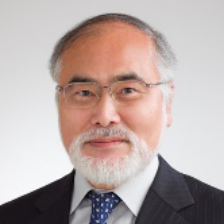
Kazuyuki Murase
Work place: Dept. of Human and Artificial Intelligence Systems, Graduate School of Engineering, University of Fukui, Japan
E-mail: murase@u-fukui.ac.jp
Website:
Research Interests: Neural Networks, Computer Networks, Network Architecture
Biography
Kazuyuki Murase received his M.E. degree in electrical engineering from Nagoya University, Nagoya, Japan, in 1978, and his Ph.D. degree in biomedical engineering from Iowa State University, Ames, IA, USA, in 1983.
He was a Research Associate with the Department of Information Science, Toyohashi University of Technology, Toyohashi, Japan, in 1984, and an Associate Professor with the Department of Information Science, Fukui University, Fukui, Japan, in 1988, and became a Professor in 1993. He served as Chairman of the Department of Human and Artificial Intelligence Systems, University of Fukui in 1999. His current research interests include neuroscience of sensory systems, self-organizing neural networks, and bio-robotics.
Author Articles
Simplified Real-, Complex-, and Quaternion-Valued Neuro-Fuzzy Learning Algorithms
By Ryusuke Hata M. A. H. Akhand Md. Monirul Islam Kazuyuki Murase
DOI: https://doi.org/10.5815/ijisa.2018.05.01, Pub. Date: 8 May 2018
The conventional real-valued neuro-fuzzy method (RNF) is based on classic fuzzy systems with antecedent membership functions and consequent singletons. Rules in RNF are made by all the combinations of membership functions; thus, the number of rules as well as total parameters increase rapidly with the number of inputs. Although network parameters are relatively less in the recently developed complex-valued neuro-fuzzy (CVNF) and quaternion neuro-fuzzy (QNF), parameters increase with number of inputs. This study investigates simplified fuzzy rules that constrain rapid increment of rules with inputs; and proposed simplified RNF (SRNF), simplified CVNF (SCVNF) and simplified QNF (SQNF) employing the proposed simplified fuzzy rules in conventional methods. The proposed simplified neuro-fuzzy learning methods differ from the conventional methods in their fuzzy rule structures. The methods tune fuzzy rules based on the gradient descent method. The number of rules in these methods are equal to the number of divisions of input space; and hence they require significantly less number of parameters to be tuned. The proposed methods are tested on function approximations and classification problems. They exhibit much less execution time than the conventional counterparts with equivalent accuracy. Due to less number of parameters, the proposed methods can be utilized for the problems (e.g., real-time control of large systems) where the conventional methods are difficult to apply due to time constrain.
[...] Read more.Producer-Scrounger Method to Solve Traveling Salesman Problem
By M. A. H. Akhand Pintu Chnadra Shill Forhad Hossain A. B. M. Junaed Kazuyuki Murase
DOI: https://doi.org/10.5815/ijisa.2015.03.04, Pub. Date: 8 Feb. 2015
Algorithms inspired from natural phenomena are seem to be efficient to solve various optimization problems. This paper investigates a new technique inspiring from the animal group living behavior to solve traveling salesman problem (TSP), the most popular combinatorial optimization problem. The proposed producer-scrounger method (PSM) models roles and interactions of three types of animal group members: producer, scrounger and dispersed. PSM considers a producer having the best tour, few dispersed members having worse tours and scroungers. In each iteration, the producer scans for better tour, scroungers explore new tours while moving toward producer’s tour; and dispersed members randomly checks new tours. For producer’s scanning, PSM randomly selects a city from the producer’s tour and rearranges its connection with several near cities for better tours. Swap operator and swap sequence based operation is employed in PSM to update a scrounger towards the producer. The proposed PSM has been tested on a large number of benchmark TSPs and outcomes compared to genetic algorithm and ant colony optimization. Experimental results revealed that proposed PSM is a good technique to solve TSP providing the best tours in most of the TSPs.
[...] Read more.Other Articles
Subscribe to receive issue release notifications and newsletters from MECS Press journals